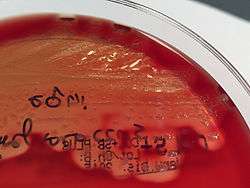Strangles

Strangles (equine distemper) is a contagious upper respiratory tract infection of horses and other equines caused by a gram-positive bacterium, Streptococcus equi.[1] As a result, the lymph nodes swell, compressing the pharynx, larynx and trachea and can cause airway obstruction leading to death, hence the name Strangles.[2] Strangles is enzootic in domesticated horses worldwide. The contagious nature of the infection has at times led to limitations on sporting events.[3]
Signs
A horse with strangles will typically develop abscesses in the lymph nodes of the head and neck causing coughing fits and difficulty swallowing. Clinical signs include fever up to 106 °F and yellow coloured nasal discharge from both the nose and eyes.[2]
Abscesses may form in other areas of the body, such as the abdomen, lungs and brain.[1] This is considered a chronic form of strangles called "bastard strangles" and can have serious implications if the abscesses rupture. Horses develop this form of strangles when their immune systems are compromised or if the bacteria rapidly invades the body.[2]
Complications
Possible complications include the horse becoming a chronic carrier of the disease, asphyxia due to enlarged lymph nodes compressing the larynx or windpipe, bastard strangles (spreading to other areas of the body), pneumonia, guttural pouch filled with pus, abscesses, purpura haemorrhagica, and heart disease. The average length for the course of this disease is 23 days.
Cause
The disease is spread by an infected horse when nasal discharge or pus from the draining lymph nodes contaminate pastures, feed troughs, brushes, bedding, tack etc.[2]
Prevention
Both intramuscular and intranasal vaccines are available. Isolation of new horses for 4 to 6 weeks, immediate isolation of infected horses, and disinfection of stalls, water buckets, feed troughs, and other equipment will help prevent the spread of strangles. As with any contagious disease, handwashing is a simple and effective tool.
Treatment
As with many streptococcal infections, penicillin or penicillin-derivative antibiotics are the most effective treatments. However, some authorities are of the opinion that use of antibiotics is contra-indicated once abscesses have begun to form, as they pre-dispose to lymphatic spread of the infection (so-called bastard strangles) which has a much higher mortality rate.
After an abscess has burst, it is very important to keep the wound clean. A diluted povidone-iodine solution has been used with good results to disinfect the open hole, flushing the inside with a syringe tipped catheter or with a teat cannula, followed by gentle scrubbing to keep the surrounding area clean.
Symptomatic therapy is an alternative treatment, and is where warm packs are used to mature the abscesses so making it less painful and more comfortable for the horse itself; but once the abscesses have been matured they must be kept clean to prevent further infections.This treatment for S.equi only helps to reduce pain for the horse rather than curing the infection.
Outcomes
Strangles has a 8.1% mortality rate.[2] Mortality is lower in cases without complications than it is in cases of bastard strangles. The disease is very contagious and morbidity is high. Precautions to limit the spread of the illness are necessary and those affected are normally isolated. An isolation period of 4–6 weeks is usually necessary to ensure that the disease is not still incubating before ending the quarantine.
Epidemiology
Equines of any age may contract the disease, although younger and elderly equines are more susceptible. Young equines may lack immunity to the disease because they have not had prior exposure. Geriatric equines may have a weaker immune system.
See also
References
- 1 2 "Strangles in Horses". www.omafra.gov.on.ca. Retrieved 2016-11-24.
- 1 2 3 4 5 "Equine Strangles" (PDF). 2008. Retrieved November 23, 2016.
- ↑ "Race club downplays 'strangles' impact". ABC.au News. 1 May 2012. Retrieved 16 May 2012.